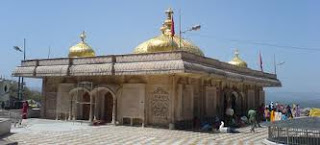Coming Date Jwalamukhi Temple Fair2013
Jwalamukhi Temple Fair will coming During Navratri month of Chaitra and Ashwin Every Year.
About Jwalamukhi Temple Fair
The Jwalamukhi fair is held twice a year during the Navratri of Chaitra and Aswin. The devotees go round the ‘Jwala Kund’ in which the sacred fire burns, making their offerings. The ‘Gorakh Tibbi’ a centre of the Gorakhpanthi Naths is placed near the Jwala Kund. Folk-dances, songs, plays, wrestling matches and athletics are some of the important attractions of the fair. The Jwalamukhi Temple in Kangra becomes the venue for the major fair.
In April and October, the people of the area who believe that the jets of the inflammable gas coming from the volcano are actually the sacred fires coming out from the mouth of their Goddess, worship the Goddess of the Jwalamukhi volcano in the district of Kangra in Himachal Pradesh.
Jwalamukhi Temple Fair Sms2013
Jwalamukhi Temple Fair History
In princely times, temple affairs were guided and supervised by the princely state of Nadaun. In 1809, Maharaja Ranjit Singh visited the temple and after dyeing his hand in saffron, stamped an agreement in the temple premises with Raja Sansar Chand-the local ruler. Later after tasting success in the Afghan war, Maharaja Ranjit Singh gilded the roof of the Jwalamukhi temple as a thanksgiving. His son Kharak Singh presented to the temple a pair of silver-plated folding doors.
Legends and Rituls of Jwalamukhi Temple Fair
One legend says that Prajapati Daksha, the father of Sati once organized a great Yajna and invited all gods except Shiva. When Sati came to know of this, she pestered Shiva to go to Yajna. Shiva maintained that they should not go uninvited. Sati argued that it was not bad to go to parents or Gurus un-invited. Shiva did not agree for himself but allowed Sati to go. On reaching her father’s house, Sati saw that no seat (assan) had been earmarked for Shiva, which meant a deliberate attempt to humiliate Shiva. She was so offended that she at once plunged herself into the havankund of Yajna. On hearing this, Shiva rushed to the spot and found Sati half burnt. Distressed Shiva carried the corpse of Sati, gyrated it from summit to summit. Apprehending a great calamity befalling, the gods ran to Lord Vishnu for help who then severed Sati’s body into pieces with his Sudarshan Chakra. Places where the pieces fell, gave rise to fifty-one Shaktipeeths, the centres where the power of goddess is inherit.
The deity is offered Bhog of Rabri or thickened milk, Misri or candy, seasonal fruits, milk and arti is done. The puja has different ‘phases’ and goes on practically the whole day. Arti is done five times in the day, Havan is performed once daily and portions of “Durga Saptasati” are recited.
About Jwalamukhi Temple

People come with red silken flags (dhwaja) to greet the Mother Goddess, ‘JwalaJi’. The fair is attributed to the worship of that Eternal Flame which is coming out of earth spontaneously and perpetually. One of the 51 Shaktipeeths of India, the temple of Jwalamukhi is in Jwalamukhi town, which is about 70 kilometers from Dharamsala. Jwalamukhi is a famous temple of Goddess Jwalamukhi, the deity of flaming mouth, believed to be the manifestation of the Goddess Sati. The building is modern with a gilt dome and pinnacles, and possesses a beautiful folding door of silver plates. The Devi appears in the form of nine different flames. The principal one is believed to be Mahakali. The other eight flames at different places in the temple represent the following Goddesses Annapurna, Chandi, Hing Laj, Vidhya Vasini, Maha Lakshmi, Maha Sarswati, Ambika and Anjana.
Jwalamukhi Temple Fair Images
 People come with red silken flags (dhwaja) to greet the Mother Goddess, ‘JwalaJi’. The fair is attributed to the worship of that Eternal Flame which is coming out of earth spontaneously and perpetually. One of the 51 Shaktipeeths of India, the temple of Jwalamukhi is in Jwalamukhi town, which is about 70 kilometers from Dharamsala. Jwalamukhi is a famous temple of Goddess Jwalamukhi, the deity of flaming mouth, believed to be the manifestation of the Goddess Sati. The building is modern with a gilt dome and pinnacles, and possesses a beautiful folding door of silver plates. The Devi appears in the form of nine different flames. The principal one is believed to be Mahakali. The other eight flames at different places in the temple represent the following Goddesses Annapurna, Chandi, Hing Laj, Vidhya Vasini, Maha Lakshmi, Maha Sarswati, Ambika and Anjana.
People come with red silken flags (dhwaja) to greet the Mother Goddess, ‘JwalaJi’. The fair is attributed to the worship of that Eternal Flame which is coming out of earth spontaneously and perpetually. One of the 51 Shaktipeeths of India, the temple of Jwalamukhi is in Jwalamukhi town, which is about 70 kilometers from Dharamsala. Jwalamukhi is a famous temple of Goddess Jwalamukhi, the deity of flaming mouth, believed to be the manifestation of the Goddess Sati. The building is modern with a gilt dome and pinnacles, and possesses a beautiful folding door of silver plates. The Devi appears in the form of nine different flames. The principal one is believed to be Mahakali. The other eight flames at different places in the temple represent the following Goddesses Annapurna, Chandi, Hing Laj, Vidhya Vasini, Maha Lakshmi, Maha Sarswati, Ambika and Anjana.













